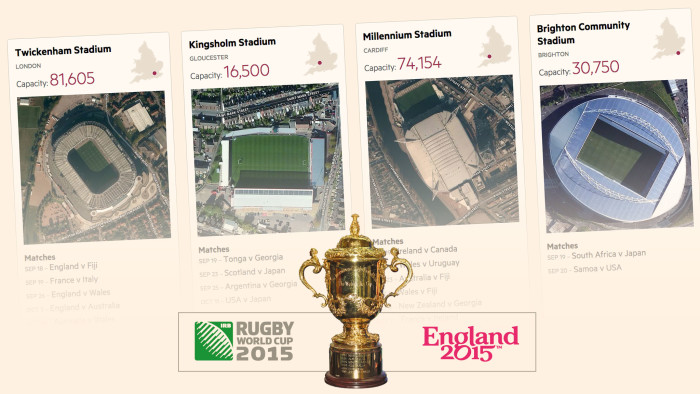Rugby World Cup comes to Brighton

Roula Khalaf, Editor of the FT, selects her favourite stories in this weekly newsletter.
The English south coast resort of Brighton has long been known as a venue for a weekend getaway, though not necessarily one where the objective has been to watch a game of rugby.
For one weekend in September there is a half-decent chance that might change, as Brighton prepares to play host to two games in the 2015 World Cup, one of which will feature the twice world champions South Africa, known as the Springboks. The hope is that such a box office attraction will spark a newfound passion for the game in Brighton and its surrounding area, among people of all generations.
The fans who once cheered on Jonny Wilkinson are now in their mid-20s and most do not play rugby any more. This was the cohort of pre-teens who were inspired to take up the game after watching England’s rugby team win the World Cup in 2003.
Fly-half Wilkinson became the poster boy for the sport in England when he scored the decisive drop goal with just 26 seconds remaining in extra time in the final against Australia in Sydney. England’s dramatic 20 points to 17 victory led to a surge in grassroots interest.
Clubs up and down the country recorded a 31 per cent increase in numbers playing mini rugby, aimed at the under-12 age group. But by the end of the following 2004 season, more than half of those children had stopped playing and they have never returned.
The governing body for the sport in England, the Rugby Football Union, is determined to avoid a similar situation arising after the country hosts the World Cup. The RFU is spending considerable sums on a marketing campaign that aims to use the profile of the event to help engage — and re-engage — people of all ages.
The FT’s guide to the 2015 Rugby World Cup

The big men are back. The world’s best 620 players (minus the infirm and overlooked) have assembled across England and Wales to contest the eighth world championship. View our interactive guide.
Read more
“Getting them through the door is easier. Keeping them there is harder,” says Mal Chumbley, the RFU development officer for the southern English counties of Sussex, Surrey, Essex and Kent.
Chumbley’s role is to carry out the RFU’s “strategic vision” to encourage more people to play rugby. The latest 2015 Sport England research suggests that 248,000 people play rugby union — one of the two main forms of full-team rugby — at least once a month, down 0.6 per cent on previous figures. The same research lists rugby as the 14th most popular participation sport in England.
Chumbley’s remit includes responsibility for developing rugby in Brighton, one of the tournament’s 13 host venues. The American Express Community Stadium, home ground of the city’s football club, Brighton and Hove Albion, is staging two early-round matches in pool B, involving Japan, Samoa and the US, as well as the South Africans.
Granted city status in 2000, Brighton was an imaginative choice by the tournament’s organising committee. It is famous for many things, but rugby is not one of them. It has long enjoyed a cosmopolitan reputation as Britain’s version of San Francisco: home to the UK’s largest gay community, a large student population and a liberal-minded political constituency, which elected Britain’s first Green MP in the 2010 general election. It also has several areas of significant economic deprivation, and drug crime levels higher than the UK average.
The county of Sussex, where Brighton is located, has 31 active rugby clubs within its borders, but these clubs are producing fewer teams than previously. In 2012 there were 104 teams; the number has dropped to 88 this year.
“Sussex punches above its weight when it comes to developing rugby players,” says Mr Chumbley. He points to the career paths of several current England internationals whose playing roots can be traced back to the county’s school and club system.
Joe Marler, Billy Twelvetrees and Joe Launchbury were each brought up in Sussex and played colts and club rugby there. Hooker Dylan Hartley’s family moved to the county from New Zealand.
Prop forward Marler’s route to the England number-one jersey illustrates the challenge that the RFU faces to keep young people engaged with the sport beyond its high-profile media moments. Sussex does not have a professional team in the Aviva Premiership, the elite domestic club competition in England. This means that talented young players such as Marler are directed elsewhere, for example to south-west London to join the youth set-up at the Harlequins club in Twickenham.
Sussex has seen participation “flatlining” over the past two years, says Mr Chumbley, a trend also discernible in some better-known rugby areas. All of which makes the next few months critical in building interest in the game in schools, universities and clubs.
Mr Chumbley is working with schools to integrate rugby into the curriculum. This goes further than providing coaching and equipment for PE lessons, and includes positioning the game within subjects such as mathematics.
“Kids are learning about angles by studying the All Blacks’ defensive line,” he says. He also draws attention to the push to include rugby’s self-proclaimed system of moral values in the way schools operate.
Tickets for the Brighton-based matches have long sold out but the event organisers expect a further 10,000 people to watch on big screens on the city’s pebble beach in sight of the Palace pier.
Comments